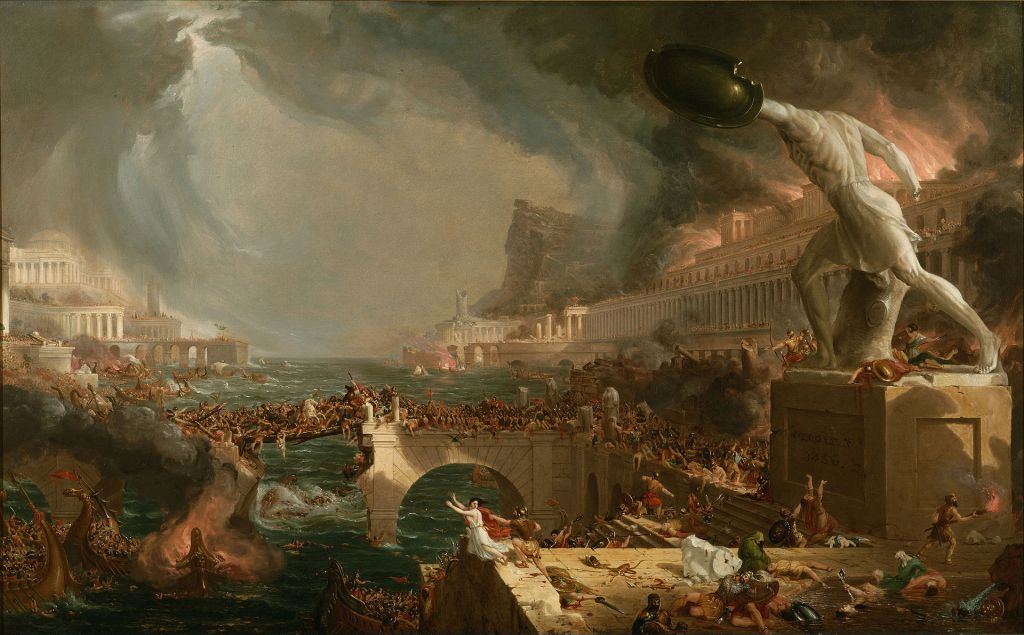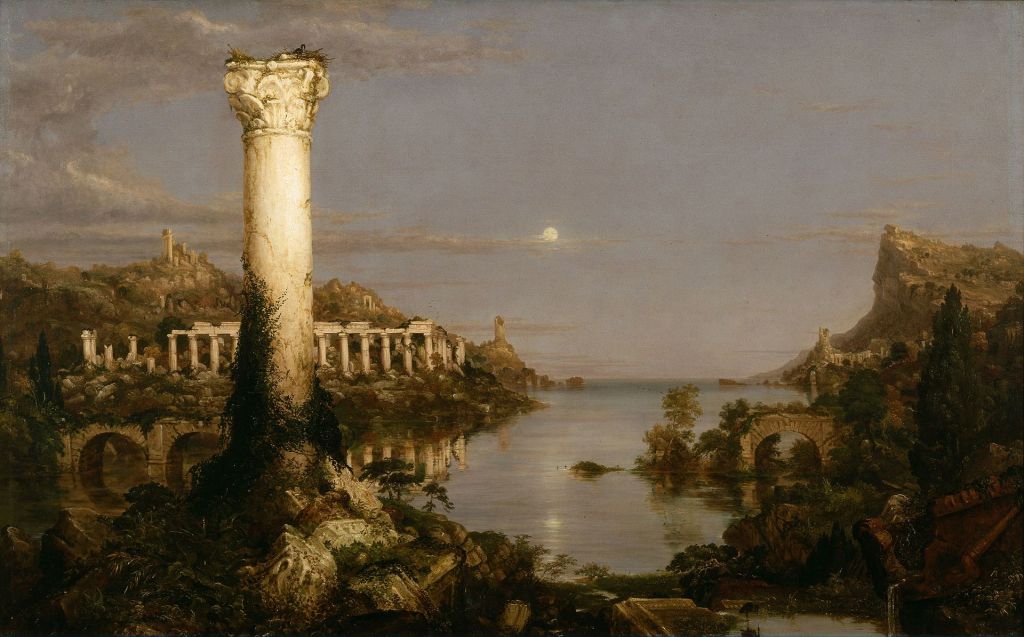Thomas Cole [1801-1848] was an English-born American painter who painted Romantic landscapes and history art. Largely self-taught, he is also known as the founder of the Hudson River School. Below are five of his paintings that have historic significance and symbolic meaning.

I. The Architect’s Dream [1840]
In this fantasy painting by Cole, which he made for the architect Ithiel Town, one architect pictured in the centre is dreaming/imagining his perfect state of the world lying down on the book of “knowledge/architectural design”. In his vision, which traces the history of architecture, the traditional Gothic architecture is left in the shadows of the trees in the left-hand corner, while his imagination paints grand façades of Roman and Greek edifices with columns and fountains – the ideal architectural design since the edifices are lit by the sunlight. There is also a pyramid seen in the distance (as well as an Egyptian temple), which probably represents the height of the architect’s imaginative whimsy since it remains an unreachable dream because of the (near-)impossibility of its construction at that time. The painting is currently housed in the Toledo Museum of Art, Ohio, USA.

II. The Titan’s Goblet [1833]
This painting is probably the most enigmatic of all Thomas Cole’s creations and has a particular “mythic” quality to it. A giant goblet is to be seen here and this goblet is overgrown with foliage. The presence of the sun in the background may signal that this goblet represents the power of one of the Titans – the sun. The miniature scale of other existence (such as boats on the water) only underscores the insignificance of it, in comparison to the past and the grandiose things that were made before. It is also on this basis that the goblet in this painting has been linked to the Norse world-tree. The water that is seen escaping from the goblet may stand for the existence/life slipping away – the metaphorical passage of time, which cannot be reversed. That passage of time is happening on such a grand scale that ordinary people cannot possibly comprehend it (fully), such as people operating the boats on the surface of the water in the goblet. The goblet, which represents time, appears even bigger than the surrounding mountains, meaning that time/life is even above the nature itself, providing a cautionary tale for humans not to squander either and always pay attention to the past. The painting is to be found in the Metropolitan Museum of Art, New York, USA.

III. The Course of Empire: Consummation [1935-36]
This painting depicts the empire (probably Rome) in its full glory – the blue skies and happy atmosphere mean that the time has come to rip the rewards of conquests and victories. The population’s stomachs are full and that means one can focus on achieving extraordinary architectural designs and indulging in cultural wonders. The white marble and gold in this painting suggest wealth and well-being, and rich people are seen enjoying the festivities. The extravagance of the elite’s display appears overwhelming in the painting, meaning that Cole undoubtedly wanted to satirise the abundance. We see little greenery in this painting as the man has the full control over his environment (to the exclusion of nature). Cole depicts the changes that befall the empire in the following two paintings (other paintings in this series (that precede Consummation) include The Savage State and The Arcadian or Pastoral State).

IV. The Course of Empire: Destruction [1836]
The empire’s years of exploitation and conquests must have consequences, as Cole suggests in this painting. In this painting, the empire, which has previously enjoyed riches and liberties, is under siege. The war is on and the enemy is upon the city. It is now the time for this city to experience pain, chaos and destruction. The weather has worsened, ships and buildings are on fire, and the rampage is through the city. Cole is clear in this painting that all the architectural beauty and subtlety cannot possibly save the population or the city, and the society should not have indulged in the abundance of resources or in the exercise of excessive powers. It should have been paying more attention to moderation, to nature and to diplomacy.

V. The Course of Empire: Desolation [1836]
In this painting, the nature is slowly taking back control after being denied supremacy for many years. We see the ruins of the edifices, including the aqueduct, and one central white column is overgrown with vegetation. The empire is now almost forgotten and no sign of human existence is to be seen anywhere. There is a strange peacefulness to this painting and the sole white column at the forefront only emphasises the new stage of loneliness and signals the return of the previous, still not fully conquered master – the state of nature.


I love the Hudson River School. This series by Cole is one of my favorites and for some reason I have always liked Desolation the best. Thanks for your commentary!
LikeLiked by 2 people
Thank you for reading! I like “Desolation” too. There is a strange quietness to the painting which I find appealing – despite its simple subject matter, it is quite thought-provoking – things spring from nature (including the man and his labours), and then return to it.
LikeLiked by 2 people
I also love the Hudson River School, particularly seeing their paintings in person.
LikeLiked by 1 person
Yes!
LikeLiked by 1 person
Interesting! As for the first painting, may I point out that Gothic actually got into it, contrary to some later architectural styles 😉 I like the triptych that forms a commentary on the life cycle of an empire – very clever!
LikeLiked by 2 people
Intriguing subject, art, and wonderful narrative.
LikeLiked by 2 people
What an interesting article! thanks for the selection.
LikeLiked by 2 people
I have seen this artist’s works in museums…remember when we could go? Thanks for this virtual visit.
LikeLiked by 2 people
I enjoyed this post a great deal, particularly your well-informed commentary.
LikeLiked by 1 person
Thank you for reading!
LikeLiked by 1 person
You’re welcome, Diana!
LikeLiked by 1 person
This post & the paintings make me want to go to an art museum . . . now! Alas, I have to go to Wal-Mart instead.
LikeLiked by 2 people
Wonderful post!
Thank you for sharing
LikeLiked by 1 person
Thank you. That last one puts me in mind of Shelley’s Ozymandias. ‘Look upon my works, ye mighty’…
LikeLiked by 1 person
A very good reference, thanks!
LikeLiked by 1 person
Loved the post (including the paintings’ locations was really helpful)! Although Cole isn’t one of my very, very favorite painters, I’m really fond of his work and jump at the chance to see any of his paintings. A couple of years ago, the Metropolitan Museum in New York had a major exhibition (called Thomas Cole’s Atlantic Crossings) and I was able to see all the Course of Empire paintings together, one after the other. What a treat! I’m totally unfamiliar with Cole’s Titan’s Goblet — what a very strange, haunting painting — I’ll have to check it out. Many thanks! There’s a very nice catalog of the Met show, BTW and here’s a link to a little info about the show, in case you’re interested:https://www.metmuseum.org/exhibitions/listings/2018/thomas-cole
LikeLiked by 2 people
Thank you! That exhibition sounds great – I wish I could go! I am glad you liked The Goblet – it is very dreamy, and I will check out that link, many thanks!
LikeLiked by 1 person
Hopefully I’ll get a chance at some point to see both The Titan’s Goblet & The Architect’s dream; they both have a fantastical quality that I really love (do you think that Thomas Cole would be illustrating fantasy novels if he lived today?) I forgot to mention that there’s another big Thomas Cole four painting series, The Voyage of Life, at Washington’s National Gallery of Art (https://www.nga.gov/collection/art-object-page.52451.html ) It’s pretty cool but its allegorical elements are much more tied to Christianity than, say, The Course of Empire and I don’t think the painting itself is quite as interesting. Still, it’s definitely worth a look if you’re there!
LikeLiked by 1 person
This looks as interesting to me, thank you! The paintings are very vivid and there is something so magically otherworldly in each of them. I also love the theme of life stages.
LikeLike
I enjoyed your thought provoking insight into Thomas Cole. I’ve never paid much attention to him until now. I will take a second look at his art.
LikeLiked by 1 person
Thank you! And yes, he does deserve attention.
LikeLike
The information you supplied with the painting was fascinating. Thanks for sharing this.
LikeLiked by 1 person